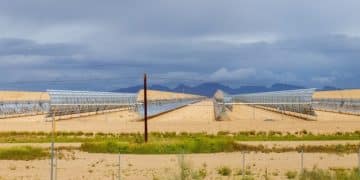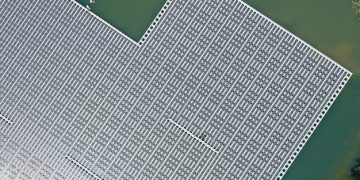Key Innovations Driving Down US Solar Energy Storage Costs

Key innovations driving down the cost of US solar energy storage systems include advancements in battery technology, economies of scale in manufacturing, streamlined installation processes, and supportive government policies and incentives.
The integration of solar energy with efficient storage solutions is rapidly transforming the US energy landscape, with costs plummeting thanks to key technological advancements. What are the key innovations driving down the cost of US solar energy storage systems?
Innovations in Battery Technology Lowering Costs
Battery technology is at the forefront of reducing solar energy storage costs. Continuous research and development efforts are yielding more efficient, durable, and cost-effective battery solutions. These advancements are critical for making solar energy a more reliable and affordable power source for homes and businesses across the US.
Lithium-Ion Battery Advancements
Lithium-ion batteries have become the dominant technology in energy storage, and ongoing improvements continue to drive down costs. These advancements include:
- Increased energy density, allowing more power to be stored in a smaller space.
- Extended lifespan, reducing the need for frequent replacements and lowering overall costs.
- Improved safety features, making lithium-ion batteries a more reliable option for residential and commercial use.
Exploring Alternative Battery Chemistries
While lithium-ion batteries lead the market, research into alternative battery chemistries is gaining momentum. These alternatives offer the potential for even lower costs and improved performance. Examples include:
- Solid-state batteries, which promise higher energy density and enhanced safety compared to traditional lithium-ion batteries.
- Flow batteries, which offer scalability and long lifespans, making them suitable for grid-scale energy storage.
- Sodium-ion batteries, utilizing more abundant and cheaper materials compared to lithium.
These battery innovations are crucial for addressing the intermittent nature of solar energy, ensuring a consistent and reliable power supply while significantly reducing storage costs.
Economies of Scale and Manufacturing Efficiencies
As the demand for solar energy storage systems increases, economies of scale are playing a significant role in reducing production costs. Streamlined manufacturing processes and increased production volumes are leading to lower prices for both batteries and other system components. This trend is essential for making solar energy storage more accessible to a wider range of consumers and businesses.
Large-Scale Manufacturing
The establishment of large-scale manufacturing facilities dedicated to battery production is a key driver of cost reduction. These facilities benefit from:
- Optimized production lines, improving efficiency and reducing waste.
- Bulk purchasing of raw materials, lowering material costs.
- Automation and advanced technologies, increasing output and reducing labor costs.
Supply Chain Optimization
Optimizing the supply chain is another critical factor in reducing manufacturing costs. This involves:
- Establishing strategic partnerships with suppliers to secure favorable pricing.
- Improving logistics and transportation to minimize delays and costs.
- Diversifying the supply base to mitigate risks associated with single-source dependencies.
These efficiencies in manufacturing and supply chain management are translating into lower prices for solar energy storage systems, making them more competitive with traditional energy sources.

Streamlined Installation Processes and Reduced Labor Costs
Installation costs can represent a significant portion of the total cost of a solar energy storage system. Streamlining these processes and reducing labor costs is essential for making solar energy storage more affordable. Innovations in installation techniques and workforce training are contributing to these cost reductions.
Prefabricated Systems
Prefabricated systems are becoming increasingly popular for solar energy storage installations. These systems are pre-assembled in a factory setting, which offers several advantages:
- Reduced on-site labor, as the system arrives ready for connection.
- Improved quality control, as the system is assembled in a controlled environment.
- Faster installation times, minimizing disruption to homeowners and businesses.
Standardized Components and Designs
Standardized components and designs also play a crucial role in streamlining installation processes. This includes:
- Simplified wiring and connections, reducing the risk of errors.
- Modular designs, allowing for flexible configurations to meet specific energy needs.
- Improved documentation and training materials, enabling faster and more efficient installations.
These innovations in installation processes are helping to drive down labor costs and make solar energy storage more accessible.
Government Policies, Incentives, and Tax Credits
Government policies and incentives play a pivotal role in accelerating the adoption of solar energy storage systems. Tax credits, rebates, and other financial incentives can significantly reduce the upfront cost of these systems, making them more attractive to homeowners and businesses. Supportive policies also create a stable market environment, encouraging investment and innovation.
Federal Tax Credits
The federal Investment Tax Credit (ITC) has been a major driver of solar energy growth in the US. This credit provides a significant tax break for homeowners and businesses that invest in solar energy systems, including storage. Key aspects include:
- A percentage-based credit on the total cost of the system.
- Eligibility for both residential and commercial installations.
- Potential for extension and modification by Congress to further incentivize solar adoption.
State and Local Incentives
In addition to federal incentives, many states and local governments offer their own programs to support solar energy storage. These incentives can include:
- Rebates for the purchase and installation of solar energy storage systems.
- Property tax exemptions for the added value of solar installations.
- Net metering policies that allow homeowners to sell excess solar energy back to the grid.
The combination of federal, state, and local incentives creates a favorable economic environment for solar energy storage, driving down costs and accelerating deployment.

Smart Inverter Technology and Grid Integration
Smart inverter technology is essential for integrating solar energy storage systems into the grid. These inverters provide advanced control and monitoring capabilities, allowing for more efficient management of energy flow and improved grid stability. Innovations in smart inverter technology are contributing to lower costs and enhanced performance.
Advanced Grid Services
Smart inverters enable solar energy storage systems to provide advanced grid services, such as:
- Frequency regulation, helping to maintain a stable grid frequency.
- Voltage support, preventing voltage fluctuations and improving power quality.
- Demand response, allowing utilities to remotely control energy use during peak demand periods.
Improved Energy Management
Smart inverters also enhance energy management capabilities. This includes:
- Real-time monitoring of energy production and consumption.
- Remote control and optimization of system performance.
- Seamless integration with smart home devices and energy management systems.
These advancements in smart inverter technology are helping to reduce the overall cost of solar energy storage by improving efficiency, reliability, and grid integration.
Increased Competition and Market Dynamics
The solar energy storage market is becoming increasingly competitive, with more companies entering the space and offering innovative products and services. This increased competition is driving down prices and encouraging innovation. Market dynamics, such as supply and demand, also play a significant role in determining costs.
Emergence of New Players
The entry of new players into the solar energy storage market is creating downward pressure on prices. These companies are often focused on:
- Developing innovative technologies to differentiate themselves from competitors.
- Offering competitive pricing to gain market share.
- Providing value-added services, such as energy management and monitoring.
Supply and Demand
The balance between supply and demand also influences the cost of solar energy storage systems. Increased demand can lead to higher prices, while oversupply can drive prices down. Factors influencing supply and demand include:
- Government policies and incentives.
- Technological advancements.
- Consumer preferences.
The competitive market dynamics and the interplay of supply and demand are contributing to lower costs and greater accessibility of solar energy storage systems in the US.
| Key Point | Brief Description |
|---|---|
| ⚡ Battery Technology | Advancements like lithium-ion and solid-state batteries improve efficiency and reduce costs. |
| 🏭 Manufacturing Scale | Economies of scale in manufacturing and supply chain optimization lower production costs. |
| 🛠️ Installation Efficiency | Prefabricated systems and standardized components reduce labor and installation time. |
| 💰 Government Incentives | Tax credits and rebates lower the initial investment for solar energy storage systems. |
Frequently Asked Questions
▼
Solar energy storage offers several benefits, including increased energy independence, reduced reliance on the grid, and the ability to use solar energy even when the sun isn’t shining. It also enhances grid stability and can lower electricity bills.
▼
Government incentives such as tax credits and rebates directly lower the upfront costs of purchasing and installing solar energy storage systems. These incentives make solar storage more financially accessible to homeowners and businesses.
▼
Advancements in battery technology, such as increased energy density, longer lifespans, and improved safety, directly contribute to lower costs by improving efficiency and reducing the need for frequent replacements.
▼
Increased competition among solar energy storage providers drives down prices as companies strive to offer more competitive pricing and innovative solutions to attract customers, leading to lower overall costs.
▼
Smart inverters are essential for integrating solar energy storage into the grid. They provide advanced control and monitoring capabilities, allowing for more efficient energy management and improved grid stability, ultimately reducing costs.
Conclusion
The cost of US solar energy storage systems is decreasing due to a combination of factors, including technological advancements in battery technology, economies of scale in manufacturing, streamlined installation processes, supportive government policies, and increased market competition. These innovations are paving the way for a more sustainable and affordable energy future in the United States.





